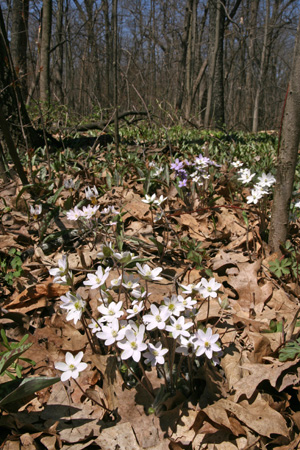
Hepatica is a genus in the buttercup family (Ranunculaceae) native to the Northern Hemisphere. This spring-blooming herbaceous perennial also goes by the common names liverleaf or liverwort. The common name comes from the supposed resemblance of the leaves to the human liver, both of which have three lobes. Because of this superficial likeness it was once thought to have medicinal properties for liver ailments. Although the leaves were once used for natural remedies and in patent medicines, they do not appear to have any chemical components with documented medicinal value and can be irritating to the skin or may be poisonous if ingested.
Hepatica grows about 12″ high and is hardy in zones 8-4a. There are two species found in Wisconsin and eastern North America, distinguished by the shape of their leaves: sharp-lobed hepatica,
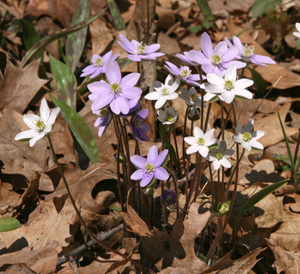
H. acutiloba (sometime treated as H. nobilis var. acuta) and round-lobed hepatica, H. americana (sometime treated as H. nobilis var. obtusa). H. acutiloba is found in rich creek bottoms and in sandier soils, while H. americana generally occurs on more acidic soils at the tops of slopes in mesic woodlands. Occasionally both species occur in the same woods and may even hybridize.
The dark green, glossy foliage is smooth and leathery with dense hairs on the undersides of the leaves. The leaves are held on long petioles arising from the crown. Each broad leaf is about 2″ wide, with the three lobes either pointed or rounded, depending on the species. The leaves are actually evergreen, turning a russet to purple color in the fall. They are ready to begin photosynthesis early in the spring before other woodland wildflowers are even up. After the new flush of leaves emerges in spring (normally after flowering), the old leaves from the previous year die back.
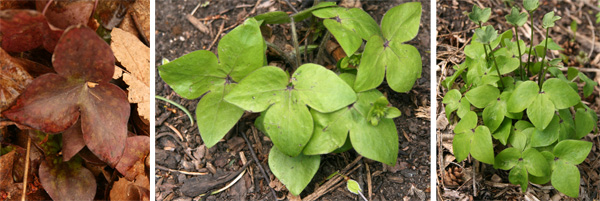
The star-shaped flowers appear singly on upright hairy stems in early spring – typically in mid-April through mid-May before the trees leaf out.
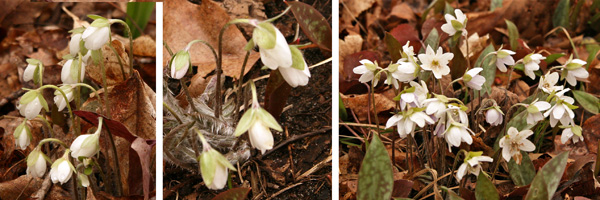
The ½ to 1 inch wide flowers have a large number of oblong white, pink, lavender, purple or bluish sepals (no petals!) surrounding numerous central stamens tipped with yellowish anthers.
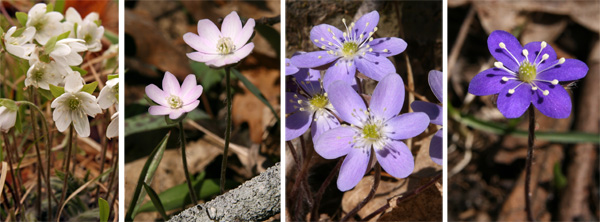
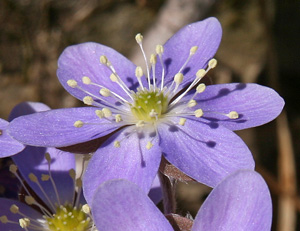
These are subtended by three green bracts. Many pollinators, including butterflies, bees, flies and beetles visit the flowers as they bloom over a period of up to a month. The flowers close at night and on cloudy days when pollinators are unlikely to be flying. But hepatica can self-pollinate, so these visitors are not necessary to produce seed (important when cold temperatures might inhibit pollinators from moving about).

The oblong fruits covered with silky hairs appear in early summer and are reported to be a favorite of chipmunks and other rodents. The seeds, which have a small, fleshy appendage called an elaisome, are dispersed by ants, who take them back to their nests to consume the fat-rich elaisomes and discard the seeds. The nutrient-rich ant middens are generally a good place for germination and ensure that the new plants grow in a spot removed from the mother plant.
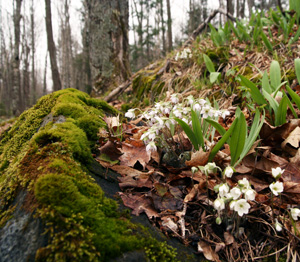
In the wild, Hepatica is usually found in high-quality, open woodlands with many native trees and herbaceous plants and few or no invasive species such as garlic mustard or buckthorn. While not typically thought of as a garden plant, Hepatica can be readily grown in rich soils in shady sites. It looks best placed in clumps of two or three or scattered about under trees with other native woodland plants including bleeding hearts (Dicentra spp.), wild geranium (Geranium maculatum), Dutchman’s breeches (Dicentra cucullaria), trilliums, woodland phlox (Phlox divaricata), and many others. The Japanese have used hepatica as a garden plant since the 18th century and have developed double flowering hepaticas.
Hepatica is a low-maintenance plant, best grown in places where it can remain undisturbed for years. However, it is easily transplanted, and specimens can be rescued from construction sites but should never be dug from intact woodland sites.
– Susan Mahr, University of Wisconsin – Madison
Ask Your Gardening Question
If you’re unable to find the information you need, please submit your gardening question here:





 Aster, Symphyotrichum spp.
Aster, Symphyotrichum spp. Fascinating Fasciation
Fascinating Fasciation Alternatives to Lawn: Groundcovers
Alternatives to Lawn: Groundcovers Marigolds
Marigolds


